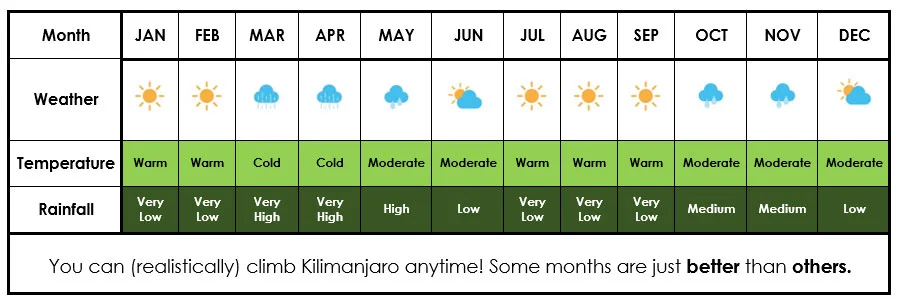
Tanzania has a pleasant, tropical climate with regional variations and wet and dry seasons. Kilimanjaro has its own microclimate due to its vast size and free-standing nature. Some say that climbing Kilimanjaro is like travelling from the equator to the North Pole, because the mountain has five distinct climate zones and you’ll pass through each of them on your way to the summit! You should therefore come ready to deal with varying conditions regardless of what time of year you decide to climb. Our comprehensive equipment list and guidance will help you prepare.

The main rainy season lasts from the end of March through to mid June. As elsewhere in the world, when exactly it rains and when it stops is impossible to predict. It’s the warmest time of the year in Tanzania, but those months are so wet that many operators simply do not offer climbs in April/May at all.
The rain gradually decreases, and so do the temperatures on Kilimanjaro. The weather on Kilimanjaro is fairly dry and clear but the nights will be bitter cold. June is quiet, but the number of climbers increases as the year progresses.
August and even more so September is the peak climbing season on Kilimanjaro. The weather is good with many clear days and warmer than in June/July. You may, however, get clouds blanketing the forest/moorland zone, and on the southern routes you may get rained on on the first days. But once you leave the rain forest behind all is good! The good conditions last into about mid Occtober when the build up for the short rains begins.
The weather on Kilimanjaro becomes more unstable and the number of climbers drops. As in all tropical regions of the world, the wetter time of the year announces itself with afternoon clouds and occasional thunderstorms. As long as you are equipped to withstand the occasional shower, this should not present any major problems.
November is the small rainy season, and the rain lasts into mid December. The temperatures have dropped and the rain brings with it all the hazards that I described at the top of the page. Not the best time to climb Kilimanjaro.
The four to six weeks around Christmas and New Year are the second peak climbing season on Kilimanjaro. Traffic is extremely high despite there still being a good chance of rainfall and thick clouds in the lower regions. It’s not a time I would choose.
Mid January to mid March is also a good time to climb Kilimanjaro. The weather is reasonable, not too cold, not too wet, and there aren’t as many climbers. The days are mainly dry, beautifully clear with few clouds and occasional brief showers. In March the chances of rain gradually increase as you approach the long rainy season. See above.
